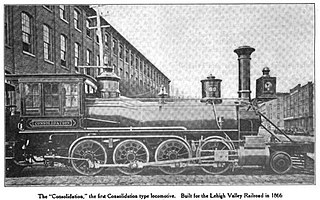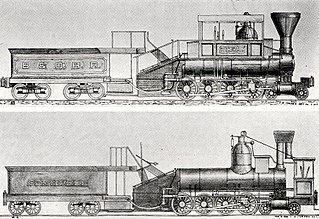Related Research Articles

Under the Whyte notation for the classification of steam locomotives, 4-6-2 represents the wheel arrangement of four leading wheels on two axles, six powered and coupled driving wheels on three axles and two trailing wheels on one axle. The 4-6-2 locomotive became almost globally known as a Pacific type.

Under the Whyte notation for the classification of steam locomotives, 4-8-4 represents the wheel arrangement of four leading wheels on two axles, eight powered and coupled driving wheels on four axles and four trailing wheels on two axles. The type was first used by the Northern Pacific Railway, and initially named the Northern Pacific, but railfans and railroad employees have shortened the name since its introduction. It is most-commonly known as a Northern.

The California State Railroad Museum is a museum in the state park system of California, United States, interpreting the role of the "iron horse" in connecting California to the rest of the nation. It is located in Old Sacramento State Historic Park at 111 I Street, Sacramento.

A 4-6-0 steam locomotive, under the Whyte notation for the classification of steam locomotives by wheel arrangement, has four leading wheels on two axles in a leading bogie and six powered and coupled driving wheels on three axles with the absence of trailing wheels.

Under the Whyte notation for the classification of steam locomotives, 2-8-0 represents the wheel arrangement of two leading wheels on one axle, usually in a leading truck, eight powered and coupled driving wheels on four axles, and no trailing wheels. In the United States and elsewhere, this wheel arrangement is commonly known as a Consolidation, after the Lehigh and Mahanoy Railroad’s Consolidation, the name of the first 2-8-0.
Under the Whyte notation for the classification of steam locomotives, 2-8-2 represents the wheel arrangement of two leading wheels on one axle, usually in a leading truck, eight powered and coupled driving wheels on four axles and two trailing wheels on one axle, usually in a trailing truck. This configuration of steam locomotive is most often referred to as a Mikado, frequently shortened to Mike.

An articulated locomotive is a steam locomotive with one or more engine units that can move independent of the main frame. Articulation allows the operation of locomotives that would otherwise be too large to negotiate a railroad's curves, whether mainlines or special lines with extreme curvature such as logging, industrial, or mountain railways.

Under the Whyte notation for the classification of steam locomotives by wheel arrangement, 4-4-2 represents a configuration of a four-wheeled leading bogie, four powered and coupled driving wheels, and two trailing wheels supporting part of the weight of the boiler and firebox. This allows a larger firebox and boiler than the 4-4-0 configuration.

The Standard class 6, otherwise known as the Clan Class, was a class of 4-6-2 Pacific tender steam locomotive designed by Robert Riddles for use by British Railways. Ten locomotives were constructed between 1951 and 1952, with a further 15 planned for construction. However, due to acute steel shortages in Britain, the order was continually postponed until it was finally cancelled on the publication of the 1955 Modernisation Plan for the re-equipment of British Railways. All of the original locomotives were scrapped, but a replica is being built.

Under the Whyte notation for the classification of steam locomotives, 4-8-0 represents the wheel arrangement of four leading wheels on two axles, usually in a leading truck or bogie, eight powered and coupled driving wheels on four axles and no trailing wheels. In North America and in some other countries the type was usually known as the Twelve-wheeler.

Under the Whyte notation for the classification of steam locomotives, a 4-8-8-2 is a locomotive with four leading wheels, two sets of eight driving wheels, and a two-wheel trailing truck.

Under the Whyte notation for the classification of steam locomotives by wheel arrangement, 4-10-2 represents the arrangement of four leading wheels, ten powered and coupled driving wheels and two trailing wheels. In South Africa, where the wheel arrangement was first used, the type was known as a Reid Tenwheeler. In the United States of America it was known as a Southern Pacific on the Southern Pacific Railroad and as an Overland on the Union Pacific Railroad.

The SR West Country and Battle of Britain classes, collectively known as Light Pacifics or informally as Spam Cans, are air-smoothed 4-6-2 Pacific steam locomotives designed for the Southern Railway by its Chief Mechanical Engineer Oliver Bulleid. Incorporating a number of new developments in British steam locomotive technology, they were amongst the first British designs to use welding in the construction process, and to use steel fireboxes, which meant that components could be more easily constructed under wartime austerity and post-war economy.

Southern Pacific Railroad's AC-1 class of cab forward steam locomotives consisted of locomotives rebuilt from MC-1 and MC-2 class locomotives that were originally built by Baldwin Locomotive Works in 1909. The MC-2 class was the first class of locomotives built and delivered to SP as cab forward locomotives in late 1909. The AC-1 class was the first of the successful AC series of cab forward locomotives that numbered nearly 200 in total on the SP. Southern Pacific No. 4002 was rebuilt in June 1923 as a Cab Forward.

Southern Pacific Railroad's MC-4 class of steam locomotive was the second class ordered and built as cab forward locomotives. Southern Pacific (SP) found the MC-2 class sufficient for a proof-of-concept for cab forward locomotives and sought to continue with now tested designs.
Southern Pacific Railroad's AC-2 class of steam locomotives was the second in the AC series of cab forward locomotives built for Southern Pacific (SP). This class consisted of locomotives that were rebuilt from Baldwin-built SP MC-4 class locomotives by 1930.
Southern Pacific Railroad's AC-3 class of steam locomotive was the 3rd and last cab forward design based on the 2-8-8-2 wheel arrangement. All 20 locomotives in this class were rebuilds from MC-6 class locomotives originally built by Baldwin Locomotive Works in 1912 and 1913. The rebuilds all took place in the late 1920s at Southern Pacific's Sacramento shops.
In Whyte notation, a 4-6-6-2 is a steam locomotive with four leading wheels in an unpowered bogie at the front of the locomotive followed by two sets of driving wheels with six wheels each, followed by two unpowered trailing wheels at the rear of the locomotive.

The National Museum of Transportation (NMOT) is a private, 42-acre transportation museum in the Kirkwood suburb of St. Louis, Missouri. Founded in 1944, it restores, preserves, and displays a wide variety of vehicles spanning 15 decades of American history: cars, boats, aircraft, and in particular, locomotives and railroad equipment from around the United States. The museum is also home to a research library of transportation-related memorabilia and documents.

The SR Merchant Navy class is a class of air-smoothed 4-6-2 Pacific steam locomotives designed for the Southern Railway by Oliver Bulleid. The Pacific design was chosen in preference to several others proposed by Bulleid. The first members of the class were constructed during the Second World War, and the last of the 30 locomotives in 1949.
References
- Drury, George H. (1993), Guide to North American Steam Locomotives, Waukesha, Wisconsin: Kalmbach Publishing Company, p. 365, ISBN 0-89024-206-2, LCCN 93041472